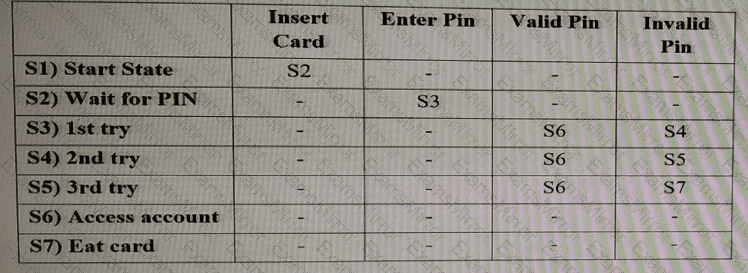New Year Special Limited Time 70% Discount Offer - Ends in 0d 00h 00m 00s - Coupon code = getmirror
Pass the ISTQB Advance Level ISTQB-CTAL-TA Questions and answers with ExamsMirror
Exam ISTQB-CTAL-TA Premium Access
View all detail and faqs for the ISTQB-CTAL-TA exam
587 Students Passed
94% Average Score
98% Same Questions
Which TWO of the following are MOST likely to be defects found as part of portability testing?
a) Insufficient, unclear installation or de-installation instructions
b) Clumsy screen navigation and input screen labeling
c) Inability to log on as an administrator
d) Time out errors when entering incorrect login details
e) The stock control barcodes cannot be read by the replaced barcode scanner
SELECT ONE OPTION
You are testing a significant enhancement to theuser interface designfor a mortgage approval program, used internally by mortgage lenders. There are many user roles involved in the process of reviewing and approving new mortgage applications. You have completed the testing that ensures the enhancements are functionally correct, and you must now ensure that the enhanced user interface meets the needs of all user roles in a way that will be considered acceptable by them.
Which test technique would be MOST suitable for this next stage of testing?
SELECT ONE OPTION:
What are ways in which classification trees support the application of pairwise testing?
a. They help to identify inputs to be used by the pairwise test technique
b. They show the combinations needed to cover all-pairs
c. They help to identify particular combinations of interest
d. They show both typical and atypical behavior
e. They show the expected results for the various test cases
Consider the following requirement:
The system shall allow cash advances of at least 200 Euros for all supported credit cards The following credit cards are supported- American Express, Diners, VISA, Mastercard and Eurocard.
The requirement has been identified as business critical.
The following test conditions have been derived:
1. The system shall allow cash advances of at least 200 Euros
2. It shall support American Express, Diners, VISA, Mastercard and Eurocard.
Assume you are following a risk-based testing strategy, where likelihood and impact are both assessed on a five-point scale ranging from very low to
very high The requirement R1 was identified as a risk item during the quality risk analysis process. In total 20 risk items were identified during this process
Assume that technical project stakeholders have assessed the likelihood of the requirement R1 risk item at a medium level Given only the information above, which of the following statements is true?
A tablet manufacturer offers the following options for its customers:
Colour:Black, White, Silver, Gold
Model:Standard, Mini, Pro
Gigabytes:32, 64, 128, 256
Connectivity:Wifi-only, Wifi+Cellular
When applying the pairwise test technique, how many TEST CASES would be needed to ensure that ALL pair combinations are tested?
SELECT ONE OPTION
Which of the following is an appropriate task for the Test Analyst to perform during the test execution phase?
You are running a regression test suite using a keyword-driven test approach for automation. The test suite has been enhanced for the current release to include:
Three new test cases covering new business functionality
Several new keywords, as project schedule constraints mean that more effective maintenance of the automated test cases is required
However, the automated suite failed unexpectedly when executing one of the new test cases, which was also utilizing a new keyword.
As Test Analyst, what should be your first step?
SELECT ONE OPTION:
A PIN entry component of an ATM system has been developed using the following state table:

Using the state transition test technique, how many 0-switch test cases are needed to achieve 100% 0-switch coverage?
A car navigation system needs to be integrated in the overall car software It is important to verify that the car navigation is functioning correctly once integrated. Thus functional correctness is considered to be important.
Which of the following techniques is most likely to support the required functional correctness testing?
An airline provides self-service check-in kiosks for passengers. The following use case has been created for the self-service check-in process.
Coverage Rules:
One test case should be designed for the basic behavior
One test case should be designed for each alternate and error handling behavior
Applying these rules to the Self Service Check-in Use Case, how many test cases should be designed?
SELECT ONE OPTION
TOP CODES
Top selling exam codes in the certification world, popular, in demand and updated to help you pass on the first try.
